Yining Wang
$λ$-GRPO: Unifying the GRPO Frameworks with Learnable Token Preferences
Oct 08, 2025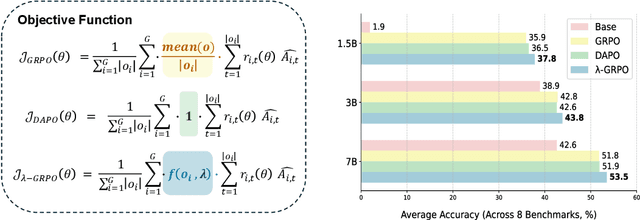
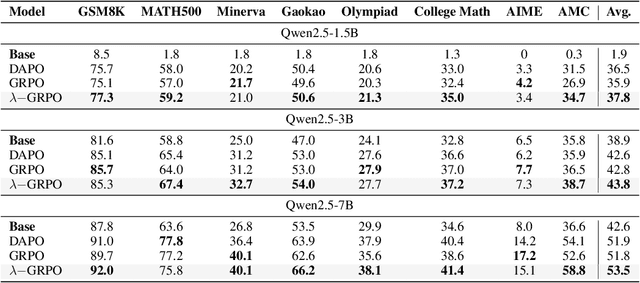
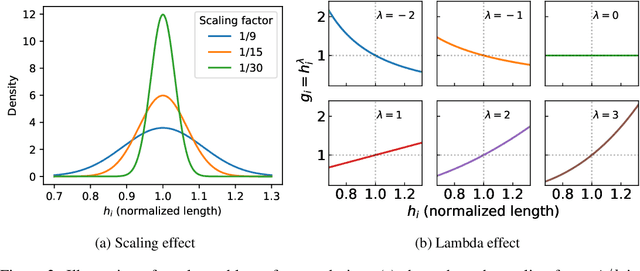
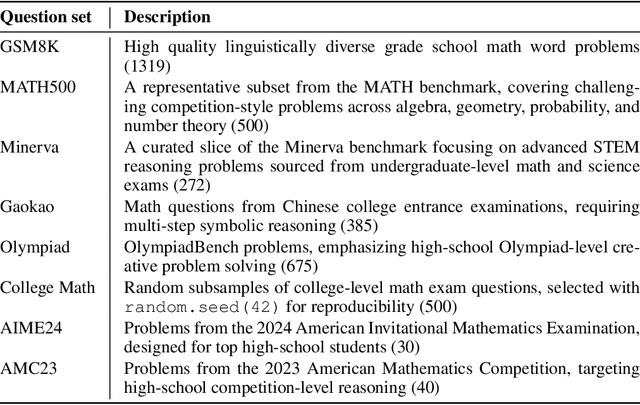
Abstract:Reinforcement Learning with Human Feedback (RLHF) has been the dominant approach for improving the reasoning capabilities of Large Language Models (LLMs). Recently, Reinforcement Learning with Verifiable Rewards (RLVR) has simplified this paradigm by replacing the reward and value models with rule-based verifiers. A prominent example is Group Relative Policy Optimization (GRPO). However, GRPO inherently suffers from a length bias, since the same advantage is uniformly assigned to all tokens of a response. As a result, longer responses distribute the reward over more tokens and thus contribute disproportionately to gradient updates. Several variants, such as DAPO and Dr. GRPO, modify the token-level aggregation of the loss, yet these methods remain heuristic and offer limited interpretability regarding their implicit token preferences. In this work, we explore the possibility of allowing the model to learn its own token preference during optimization. We unify existing frameworks under a single formulation and introduce a learnable parameter $\lambda$ that adaptively controls token-level weighting. We use $\lambda$-GRPO to denote our method, and we find that $\lambda$-GRPO achieves consistent improvements over vanilla GRPO and DAPO on multiple mathematical reasoning benchmarks. On Qwen2.5 models with 1.5B, 3B, and 7B parameters, $\lambda$-GRPO improves average accuracy by $+1.9\%$, $+1.0\%$, and $+1.7\%$ compared to GRPO, respectively. Importantly, these gains come without any modifications to the training data or additional computational cost, highlighting the effectiveness and practicality of learning token preferences.
ReasoningGuard: Safeguarding Large Reasoning Models with Inference-time Safety Aha Moments
Aug 06, 2025Abstract:Large Reasoning Models (LRMs) have demonstrated impressive performance in reasoning-intensive tasks, but they remain vulnerable to harmful content generation, particularly in the mid-to-late steps of their reasoning processes. Existing defense mechanisms, however, rely on costly fine-tuning and additional expert knowledge, which restricts their scalability. In this work, we propose ReasoningGuard, an inference-time safeguard for LRMs, which injects timely safety aha moments to steer harmless while helpful reasoning processes. Leveraging the model's internal attention behavior, our approach accurately identifies critical points in the reasoning path, and triggers spontaneous, safety-oriented reflection. To safeguard both the subsequent reasoning steps and the final answers, we further implement a scaling sampling strategy during the decoding phase, selecting the optimal reasoning path. Inducing minimal extra inference cost, ReasoningGuard effectively mitigates three types of jailbreak attacks, including the latest ones targeting the reasoning process of LRMs. Our approach outperforms seven existing safeguards, achieving state-of-the-art safety defenses while effectively avoiding the common exaggerated safety issues.
Cardiac-CLIP: A Vision-Language Foundation Model for 3D Cardiac CT Images
Jul 29, 2025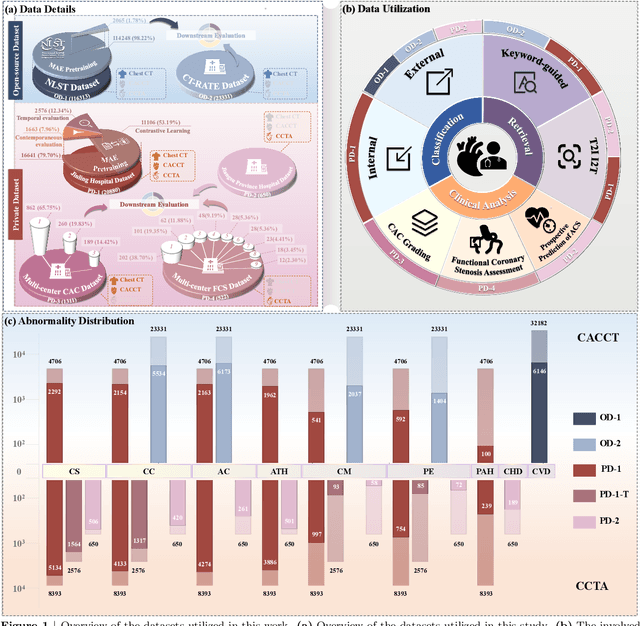
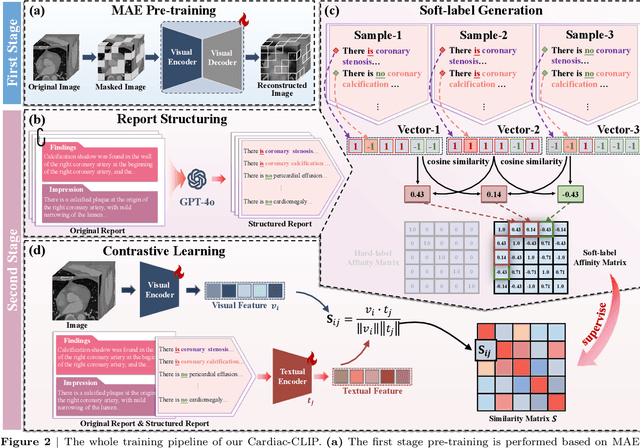
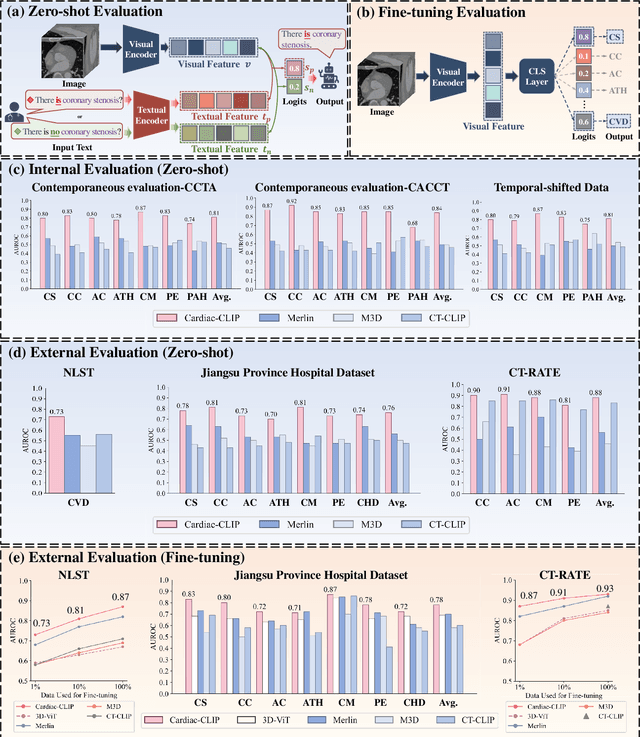
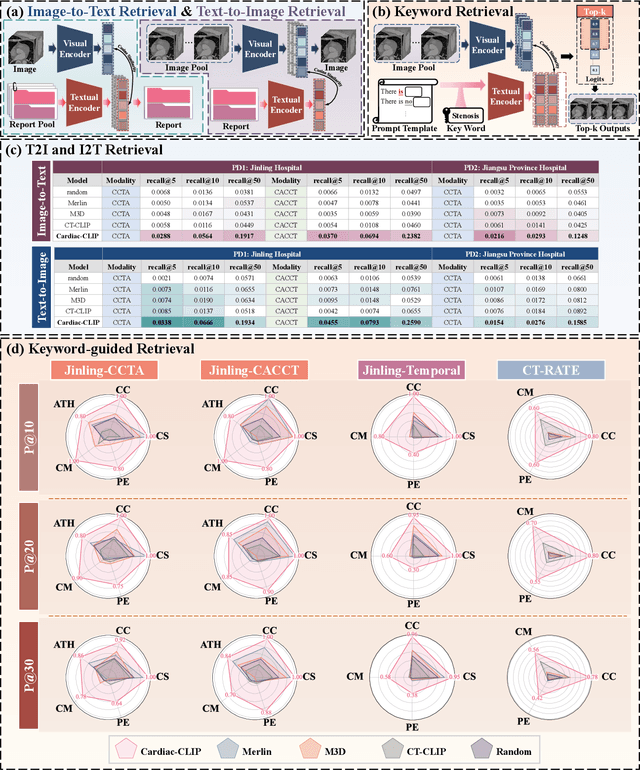
Abstract:Foundation models have demonstrated remarkable potential in medical domain. However, their application to complex cardiovascular diagnostics remains underexplored. In this paper, we present Cardiac-CLIP, a multi-modal foundation model designed for 3D cardiac CT images. Cardiac-CLIP is developed through a two-stage pre-training strategy. The first stage employs a 3D masked autoencoder (MAE) to perform self-supervised representation learning from large-scale unlabeled volumetric data, enabling the visual encoder to capture rich anatomical and contextual features. In the second stage, contrastive learning is introduced to align visual and textual representations, facilitating cross-modal understanding. To support the pre-training, we collect 16641 real clinical CT scans, supplemented by 114k publicly available data. Meanwhile, we standardize free-text radiology reports into unified templates and construct the pathology vectors according to diagnostic attributes, based on which the soft-label matrix is generated to supervise the contrastive learning process. On the other hand, to comprehensively evaluate the effectiveness of Cardiac-CLIP, we collect 6,722 real-clinical data from 12 independent institutions, along with the open-source data to construct the evaluation dataset. Specifically, Cardiac-CLIP is comprehensively evaluated across multiple tasks, including cardiovascular abnormality classification, information retrieval and clinical analysis. Experimental results demonstrate that Cardiac-CLIP achieves state-of-the-art performance across various downstream tasks in both internal and external data. Particularly, Cardiac-CLIP exhibits great effectiveness in supporting complex clinical tasks such as the prospective prediction of acute coronary syndrome, which is notoriously difficult in real-world scenarios.
Continuum-armed Bandit Optimization with Batch Pairwise Comparison Oracles
May 28, 2025Abstract:This paper studies a bandit optimization problem where the goal is to maximize a function $f(x)$ over $T$ periods for some unknown strongly concave function $f$. We consider a new pairwise comparison oracle, where the decision-maker chooses a pair of actions $(x, x')$ for a consecutive number of periods and then obtains an estimate of $f(x)-f(x')$. We show that such a pairwise comparison oracle finds important applications to joint pricing and inventory replenishment problems and network revenue management. The challenge in this bandit optimization is twofold. First, the decision-maker not only needs to determine a pair of actions $(x, x')$ but also a stopping time $n$ (i.e., the number of queries based on $(x, x')$). Second, motivated by our inventory application, the estimate of the difference $f(x)-f(x')$ is biased, which is different from existing oracles in stochastic optimization literature. To address these challenges, we first introduce a discretization technique and local polynomial approximation to relate this problem to linear bandits. Then we developed a tournament successive elimination technique to localize the discretized cell and run an interactive batched version of LinUCB algorithm on cells. We establish regret bounds that are optimal up to poly-logarithmic factors. Furthermore, we apply our proposed algorithm and analytical framework to the two operations management problems and obtain results that improve state-of-the-art results in the existing literature.
UORA: Uniform Orthogonal Reinitialization Adaptation in Parameter-Efficient Fine-Tuning of Large Models
May 26, 2025Abstract:This paper introduces Uniform Orthogonal Reinitialization Adaptation (UORA), a novel parameter-efficient fine-tuning (PEFT) approach for Large Language Models (LLMs). UORA achieves state-of-the-art performance and parameter efficiency by leveraging a low-rank approximation method to reduce the number of trainable parameters. Unlike existing methods such as LoRA and VeRA, UORA employs an interpolation-based reparametrization mechanism that selectively reinitializes rows and columns in frozen projection matrices, guided by the vector magnitude heuristic. This results in substantially fewer trainable parameters compared to LoRA and outperforms VeRA in computation and storage efficiency. Comprehensive experiments across various benchmarks demonstrate UORA's superiority in achieving competitive fine-tuning performance with negligible computational overhead. We demonstrate its performance on GLUE and E2E benchmarks and its effectiveness in instruction-tuning large language models and image classification models. Our contributions establish a new paradigm for scalable and resource-efficient fine-tuning of LLMs.
* 20 pages, 2 figures, 15 tables
A topology-preserving three-stage framework for fully-connected coronary artery extraction
Apr 02, 2025Abstract:Coronary artery extraction is a crucial prerequisite for computer-aided diagnosis of coronary artery disease. Accurately extracting the complete coronary tree remains challenging due to several factors, including presence of thin distal vessels, tortuous topological structures, and insufficient contrast. These issues often result in over-segmentation and under-segmentation in current segmentation methods. To address these challenges, we propose a topology-preserving three-stage framework for fully-connected coronary artery extraction. This framework includes vessel segmentation, centerline reconnection, and missing vessel reconstruction. First, we introduce a new centerline enhanced loss in the segmentation process. Second, for the broken vessel segments, we further propose a regularized walk algorithm to integrate distance, probabilities predicted by a centerline classifier, and directional cosine similarity, for reconnecting the centerlines. Third, we apply implicit neural representation and implicit modeling, to reconstruct the geometric model of the missing vessels. Experimental results show that our proposed framework outperforms existing methods, achieving Dice scores of 88.53\% and 85.07\%, with Hausdorff Distances (HD) of 1.07mm and 1.63mm on ASOCA and PDSCA datasets, respectively. Code will be available at https://github.com/YH-Qiu/CorSegRec.
TROVE: A Challenge for Fine-Grained Text Provenance via Source Sentence Tracing and Relationship Classification
Mar 19, 2025



Abstract:LLMs have achieved remarkable fluency and coherence in text generation, yet their widespread adoption has raised concerns about content reliability and accountability. In high-stakes domains such as healthcare, law, and news, it is crucial to understand where and how the content is created. To address this, we introduce the Text pROVEnance (TROVE) challenge, designed to trace each sentence of a target text back to specific source sentences within potentially lengthy or multi-document inputs. Beyond identifying sources, TROVE annotates the fine-grained relationships (quotation, compression, inference, and others), providing a deep understanding of how each target sentence is formed. To benchmark TROVE, we construct our dataset by leveraging three public datasets covering 11 diverse scenarios (e.g., QA and summarization) in English and Chinese, spanning source texts of varying lengths (0-5k, 5-10k, 10k+), emphasizing the multi-document and long-document settings essential for provenance. To ensure high-quality data, we employ a three-stage annotation process: sentence retrieval, GPT provenance, and human provenance. We evaluate 11 LLMs under direct prompting and retrieval-augmented paradigms, revealing that retrieval is essential for robust performance, larger models perform better in complex relationship classification, and closed-source models often lead, yet open-source models show significant promise, particularly with retrieval augmentation.
Dynamic Pricing with Adversarially-Censored Demands
Feb 10, 2025
Abstract:We study an online dynamic pricing problem where the potential demand at each time period $t=1,2,\ldots, T$ is stochastic and dependent on the price. However, a perishable inventory is imposed at the beginning of each time $t$, censoring the potential demand if it exceeds the inventory level. To address this problem, we introduce a pricing algorithm based on the optimistic estimates of derivatives. We show that our algorithm achieves $\tilde{O}(\sqrt{T})$ optimal regret even with adversarial inventory series. Our findings advance the state-of-the-art in online decision-making problems with censored feedback, offering a theoretically optimal solution against adversarial observations.
OphthBench: A Comprehensive Benchmark for Evaluating Large Language Models in Chinese Ophthalmology
Feb 03, 2025Abstract:Large language models (LLMs) have shown significant promise across various medical applications, with ophthalmology being a notable area of focus. Many ophthalmic tasks have shown substantial improvement through the integration of LLMs. However, before these models can be widely adopted in clinical practice, evaluating their capabilities and identifying their limitations is crucial. To address this research gap and support the real-world application of LLMs, we introduce the OphthBench, a specialized benchmark designed to assess LLM performance within the context of Chinese ophthalmic practices. This benchmark systematically divides a typical ophthalmic clinical workflow into five key scenarios: Education, Triage, Diagnosis, Treatment, and Prognosis. For each scenario, we developed multiple tasks featuring diverse question types, resulting in a comprehensive benchmark comprising 9 tasks and 591 questions. This comprehensive framework allows for a thorough assessment of LLMs' capabilities and provides insights into their practical application in Chinese ophthalmology. Using this benchmark, we conducted extensive experiments and analyzed the results from 39 popular LLMs. Our evaluation highlights the current gap between LLM development and its practical utility in clinical settings, providing a clear direction for future advancements. By bridging this gap, we aim to unlock the potential of LLMs and advance their development in ophthalmology.
Mirage in the Eyes: Hallucination Attack on Multi-modal Large Language Models with Only Attention Sink
Jan 25, 2025



Abstract:Fusing visual understanding into language generation, Multi-modal Large Language Models (MLLMs) are revolutionizing visual-language applications. Yet, these models are often plagued by the hallucination problem, which involves generating inaccurate objects, attributes, and relationships that do not match the visual content. In this work, we delve into the internal attention mechanisms of MLLMs to reveal the underlying causes of hallucination, exposing the inherent vulnerabilities in the instruction-tuning process. We propose a novel hallucination attack against MLLMs that exploits attention sink behaviors to trigger hallucinated content with minimal image-text relevance, posing a significant threat to critical downstream applications. Distinguished from previous adversarial methods that rely on fixed patterns, our approach generates dynamic, effective, and highly transferable visual adversarial inputs, without sacrificing the quality of model responses. Comprehensive experiments on 6 prominent MLLMs demonstrate the efficacy of our attack in compromising black-box MLLMs even with extensive mitigating mechanisms, as well as the promising results against cutting-edge commercial APIs, such as GPT-4o and Gemini 1.5. Our code is available at https://huggingface.co/RachelHGF/Mirage-in-the-Eyes.
 Add to Chrome
Add to Chrome Add to Firefox
Add to Firefox Add to Edge
Add to Edge